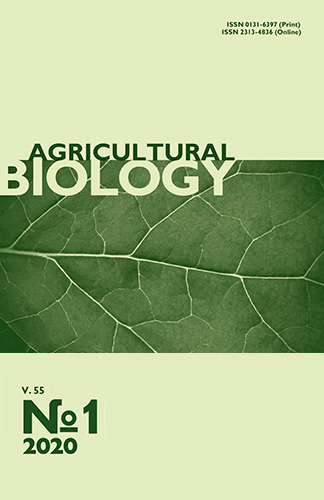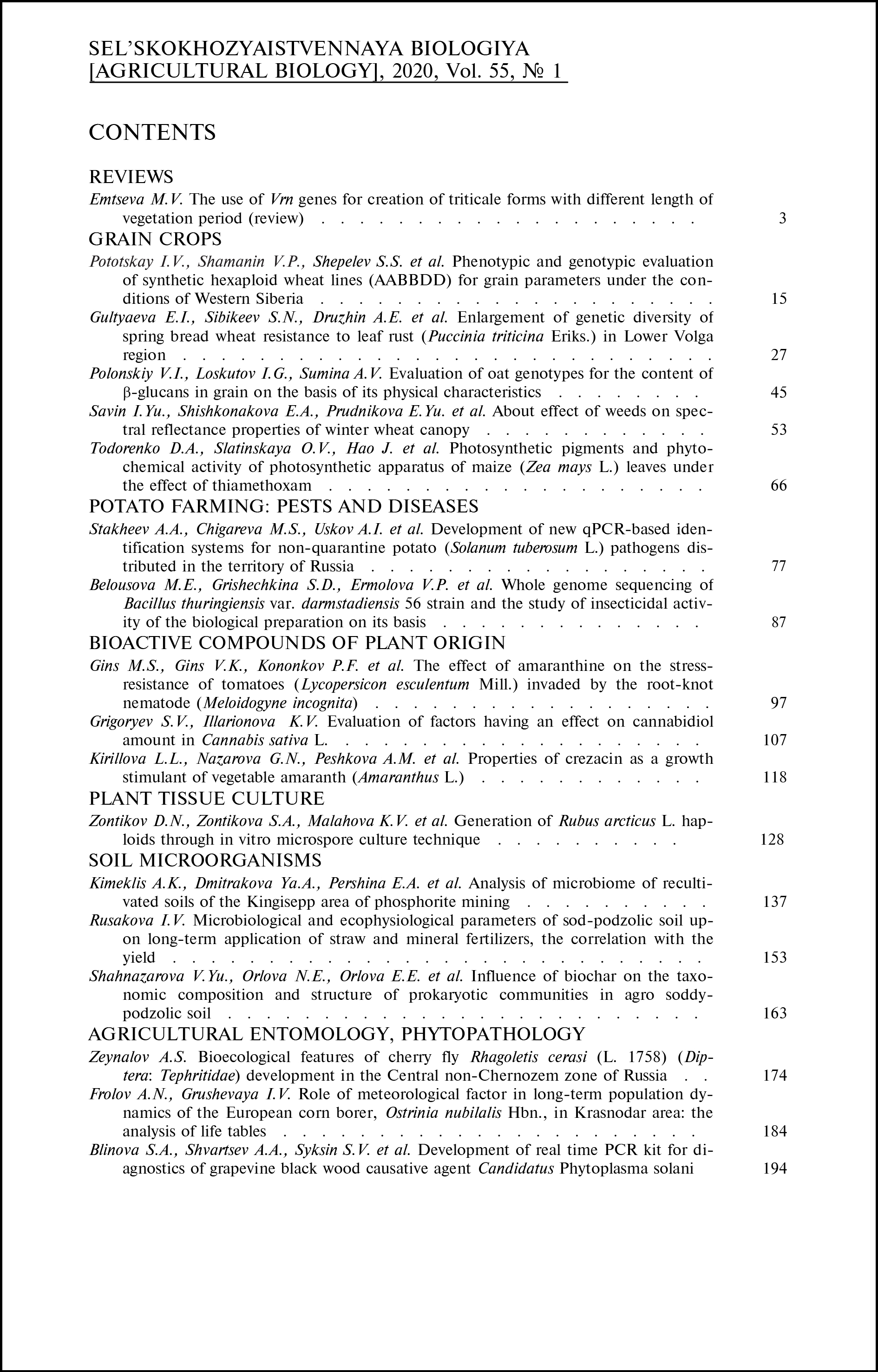doi: 10.15389/agrobiology.2020.1.107eng
UDC: 633.522:57.04
Acknowledgements:
The authors are sincerely grateful to the State Anti-Drug Committee and the Federal Drug Control Service of the Russian Federation for their support in conducting research.
The work corresponds to the VIR thematic plan on the topic No. 0662-2019-0001 "VIR Collection of oilseeds and spinning crops (genetic diversity research and improvement)".
EVALUATION OF FACTORS HAVING AN EFFECT ON CANNABIDIOL
AMOUNT IN Cannabis sativa L.
S.V. Grigoryev1, K.V. Illarionova2
1Federal Research Center Vavilov All-Russian Institute of Plant Genetic Resources, 42-44, ul. Bol’shaya Morskaya, St. Petersburg, 190000 Russia, e-mail ser.grig@mail.ru (✉ corresponding author);
2Peter the Great St. Petersburg Polytechnic University, 29, ul. Politechnicheskaya, St. Petersburg, 195251 Russia,
e-mail elkv@mail.ru
ORCID:
Grigoryev S.V. orcid.org/0000-0001-7670-4360
Illarionova K.V. orcid.org/0000-0002-2563-6094
Received August 22, 2019
Industrial hemp is a multipurpose crop, supplying fibers, seeds, and pharmaceuticals. The non-psychotropic cannabidiol (CBD) derived from hemp is a promising pharmaceutical raw material. It shows no psychotropic effects, is not listed in UN Single Convention on Narcotic Drugs, but demanded for the production of medicine products. Regretfully, there are no domestic cultivars of hemp in Russia specialized in phytocannabidiol. Currently, there is a big need in industrial varieties of pharmaceutical specialization (CBD-cultivars). This paper is the first to report on selection of the accessions with high CBD content (above 9 %) and trace amounts of Δ9-tetrahydrocannabinol (THC), the main psychotropic cannabinoid, among the studied genotypic diversity of hemp plants. The objective of the study was the assessment of the effects of field watering, lighting conditions, sexual type of plants and stage of ontogenesis on CBD and THC accumulation on a broad in situ genotypic diversity of Cannabis L. germplasm accessions in order to form the optimal morpho-physiological and agronomical model of CBD-producing cultivar (ideotype) well adapted to field growing. Cannabis populations in situ, genotypically original, spatially separated (and, thus, not undergone to random cross pollination), were surveyed in 2008-2011 in four Russian regions. A total of 128 populations were selected for the research; among them, 52 populations were studied for the effect of shading, and 58 for the moisture excess/deficit. For each population, plants (not less than n = 10 per each variant, i.e. shading vs. lighting, and moisture excess vs. deficit) were collected randomly and representatively to form summarized sample, and then analyzed to reveal the effect of the said factors. The plants were collected from initial budding and flowering of male plants, up to the moment when fimbles have just begun to dry out and the first seeds at the basal parts of female inflorescences have started to ripen. Air-dry samples (with and without inflorescences, female plants, male plants) were crushed and biochemically analyzed. Inflorescences (generative parts) and only leaves (vegetative parts) of the two conventional sexual types were analyzed separately. The analysis of the CBD and THC contents in the studied accessions revealed a statistically significant (p = 0.05) genotypic variability for CBD between the samples. Natural sexual polymorphism in the content of CBD and THC is statistically unreliable. Both male and female plants contain approximately equal CBD concentrations from the budding time until the seed ripening. THC amount was insignificantly increased in female plants. From the budding phase until the start of seed ripening, plants increase their CBD content more than twice. From the budding phase until the seed ripening, CBD amount in inflorescences is significantly thrice more than in vegetative parts. The difference in THC content is significant as well, but not so noteworthy. By the start of budding of different sexual types CBD content in generative parts is twice as high as that of THC. CBD accumulation reaches its maximum in generative plant parts by the time when seed ripening starts initially. The effect of shading on plants of any sexual type has shown that CBD content significantly responds to the exposure and intensity of natural lighting. Any breach in daylight illumination will reduce the CBD content. The factor of excessive/deficient natural moistening has no significant effect on CBD and THC accumulation in plants, regardless of the development phase of an adult plant of any sexual type. Unlike to dioecious cultivars specialized for seed/oil production, both female and male plants may be used for CBD production. Female plants must have extended time of budding—full flowering in conditions of reduced amounts of pollen in air and deferred seed ripening. Flowering and maximum pollen production from male plants must be deferred, because the lack of pollen in field promotes CBD formation in female inflorescences. CBD cultivar plants should have a maximum inflorescence size, a maximum budding and flowering period, and a minimum foliage.
Keywords: Cannabis sativa L., C. ruderalis L., hemp, plant sexual types, phytocannabinoids, cannabidiol, Δ9-tetrahydrocannabinol, CBD-cultivar ideotype, breeding.
REFERENCES
- Clarke R.C., Merlin M.D. Cannabis: evolution and ethnobotany. University of California Press, Berkeley, Los Angeles, London, 2013.
- Filippova N.V., Baryl'nik Yu.B., Deeva M.A., Sobakina O.Yu. Narkologiya, 2015, 14, 8(164): 86-90 (in Russ.).
- Yang Y., Lewis M.M., Bello A.M., Wasilewski E., Clarke H.A., Kotra L.P. Cannabis sativa (hemp) seed Δ9-tetrahydrocannabinol and potential overdose. Cannabis and Cannabinoids Research, 2017, 2(1): 274-281 CrossRef
- Fletcher R.S., McKay J. Industrial hemp Cannabis cultivars and seeds with stable cannabinoid profiles. United States Patent Application Publication. Pub. No.: US 2017/0339907 A1. New West Genetics, Ft. Collins, CO (US). Nov. 30, 2017.
- Grotenhermen F., Karus M. Industrial hemp is not marijuana: comment on the drug potential of fiber Cannabis. Journal of the International Hemp Association, 1998, 5(2): 96-99.
- Pertwee R. The therapeutic potential of Cannabis and cannabinoids for multiple sclerosis and spinal injury. Journal of the International Hemp Association, 1999, 4(1): 1-7.
- Fernández-Ruiz J., Sagredo O., Pazos M.R., García C., Pertwee R., Mechoulam R., Martínez-Orgado J. Cannabidiol for neurodegenerative disorders: important new clinical applications for this phytocannabinoid? British Journal of Clinical Pharmacology, 2013, 75(2): 323-333 CrossRef
- Boehnke K.F., Scott J.R., Litinas E., Sisley S., Williams D.A., Clauw D.J. Pills to pot: observational analyses of cannabis substitution among medical cannabis users with chronic pain. Journal of Pain, 2019, 20(7): 830-841 CrossRef
- McAllister S.D., Christian R.T., Horowitz M.P., Garcia A., Desprez P.Y. Cannabidiol as a novel inhibitor of Id-1 gene expression in aggressive breast cancer cells. Molecular Cancer Therapeutics, 2007, 6(11): 2921-2927 CrossRef
- McAllister S.D., Soroceanu L., Desprez P.Y. The antitumor activity of plant-derived non-psychoactive cannabinoids. Journal of Neuroimmune Pharmacology, 2015, 10(2): 255-267 CrossRef
- Molchanova A.Yu., Ulashchik V.S. Zdravookhranenie, 2015, 2: 32-40 (in Russ.).
- Reiman A., Welty M., Solomon P. Cannabis as a substitute for opioid-based pain medication: patient self-report. Cannabis and Cannabinoid Research, 2017, 2(1): 160-166 CrossRef
- Khan S.P., Pickens T.A., Berlau D.J. Perspectives on cannabis as a substitute for opioid analgesics. Pain Management, 2019, 9(2): 191-203 CrossRef
- Petrov S.Yu., Vostrukhin S.V., Safonova D.M. Natsional'nyi zhurnal glaukoma, 2016, 15(4): 95-100 (in Russ.).
- Russo E.B. Taming THC: potential cannabis synergy and phytocannabinoid-terpenoid entourage effects. British Journal of Pharmacology,2011, 163(7): 1344-1364 CrossRef.
- Chandra S., Lata H., ElSohly M.A., Walker L.A., Potter D. Cannabis cultivation: methodological issues for obtaining medical-grade product. Epilepsy & Behavior, 2017, 70: 302-312 CrossRef
- Lewis M.A., Russo E.B., Smith K.M. Pharmacological foundations of Cannabis chemovars. Planta Med., 2018, 84(4): 225-233 CrossRef
- Zelenina O.N., Smirnov A.A. Niva Povolzh'ya, 2010, 4(17): 16-20 (in Russ.).
- Zelenina O.N., Serkov V.A., Smirnov A.A. Vestnik Rossiiskoi akademii sel'skokhozyaistvennykh nauk, 2012, 4: 61-64 (in Russ.).
- Serkov V.A., Klimova L.V., Danilov M.V. Niva Povolzh'ya, 2018, 3(48): 62-67 (in Russ.).
- Mishchenko S.V., Laiko I.M. Nakoplenie kannabidiola v ontogeneze rastenii tekhnicheskoi (promyshlennoi) konopli. Plant Varieties Studying and Protection, 2018, 14(4): 390-399.
- Welling M.T., Shapter T., Rose T.J., Liu L., Stanger R., King G.J. A belated green revolution for Cannabis: virtual genetic resources to fast-track cultivar development. Frontiers in Plant Science, 2016, 29(7): 1113 CrossRef
- Galasso I., Russo R., Mapelli S., Ponzoni E., Brambilla I.M., Battelli G., Reggiani R. Variability in seed traits in a collection of Cannabis sativa L. genotypes. Frontiers in Plant Science, 2016, 20(7): 688 CrossRef
- Shelenga T.V., Grigor'ev S.V., Illarionova K.V. Trudy po prikladnoi botanike, genetike i selektsii, 2012, 170: 208-215 (in Russ.).
- Laiko I.M., Virovets V.G., Kirichenko A.I., Mishchenko S.V. V sbornike: Resursosberegayushchie ekologicheski bezopasnye tekhnologii proizvodstva i pererabotki sel'skokhozyaistvennoi produktsii [In: Resource-saving environmentally friendly technologies for the production and processing of agricultural products]. Saransk, 2014: 194-200 (in Russ.).
- Gagne S.J., Stout J.M., Liu E., Boubakir Z., Clark S. M., Page J.M. Identification of olivetolic acid cyclase from Cannabis sativa reveals a unique catalytic route to plant polyketides. Proceedings of the National Academy of Science, 2017, 109(31): 12811-12816 CrossRef
- Small E. Dwarf germplasm: the key to giant Cannabis hempseed and cannabinoid crops. Genetic Resources and Crop Evolution, 2018, 65(4): 1071-1107 CrossRef












